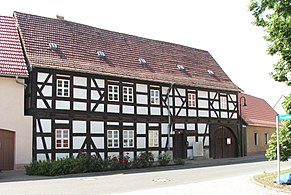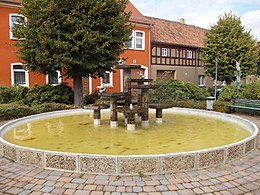Wahrenbrück
Wahrenbrück is a district of the city of Uebigau-Wahrenbrück in the Brandenburg district of Elbe-Elster and is located about five kilometers north of the city of Bad Liebenwerda at the confluence of the Kleiner Elster and the Schwarze Elster .
history
Interpretation of the place name
Uardenbruke (Wardenbrücke) is made up of the unique word waiting , which on the one hand means "observation" or is derived from the Old High German warta as "warn" and "true" and "bridge" together. Accordingly, a bridge at a control room .
City arms
A vaulted, three-arched silver bridge in red, set with a pointed silver tower.
The coat of arms of Wahrenbrück is a talking coat of arms , a watchtower or watch tower on a bridge describes the city name.
Even the oldest seal in the city contained a coat of arms, which showed a bridge in plan view with a chain on each side. Signature of the seal was S. DER RADT CZV WARDENBRVCKE SAX (= in Saxony)
The above coat of arms is part of the seal from 1657 with the signature DES STEDTLEINS WARENBRUCK SIGL 1657 .
Local history
In 1199 Konrad II von Landsberg laid the boundaries of the Dobrilugk monastery in Villa Uardenbruke . There was probably a castle at the transition to the Schwarzen Elster . 1202 arbitrated Konrad II. A dispute between the priest Hartbertus and the monastery of Cistercian in Dobrilugk . In 1210 Conrad II donated 16 Hufen in Lupsch to the monastery in Villa Wardenbrucke . In 1251 Heinrich the Illustrious gave the monastery in Dobrilugk patronage over the church in Wahrenbrück. In the Treaty of Rochlitz in 1289, Albrecht the Degenerate promised his son Friedrich Tuta the area, but then sold it to Friedrich I of Meissen . In 1300 Dietrich IV. , Albrecht's son, owned the place and the Dobrilugk monastery bought the mill in the place from Otto von Ileburg. In the Treaty of Tangermünde 1312, Wahrenbrück was awarded to Brandenburg . In 1340 Wahrenbrück was first mentioned as an oppidum (city) in an Ileburg document . The city was pledged to Meissen by the Brandenburgers in 1347, 1350 and 1353 and finally sold. Around 1383 Wahrenbrück came into the possession of Kursachsen . The Ileburger owned the city of Wahrenbrück together with other cities such as Liebenwerda , Uebigau , Sonnewalde , Dahlen , Strehla and the villages of Bönitz , Schmerkendorf, Marxdorf , Kölsa, Zinsdorf , Grabo (wüst) , Kiebitz, Bomsdorf , Langennaundorf , Beutersitz , Wildgrube . Since the 13th century, the Ileburger appeared first as bailiffs and later as owners. From 1384 the rule of Electoral Saxony was pledged to the Lords of Köckritz and partially redeemed in 1385 and then completely again in 1391. In 1422 Wahrenbrück was part of the personal treasure of Duchess Offka , widow of Elector Albrecht III. ; In 1459 the city of Wahrenbrück was included in the Bohemian-Saxon legacy .
During the Thirty Years' War the city was burned by Croats in 1631 , besieged and destroyed by Swedish troops in 1637 and 1643, and the plague raged, so that only five to six men survived. The inhabitants lived from agriculture, animal husbandry and handicrafts . The city took over the wax , honey and bees market from Buckowien . The school was built between 1529 and 1533. In 1710 the cantor school was built. At times up to 13 villages were parish in Wahrenbrück. In 1730 the Kursächsische Postmeile Pillar was built directly on the bridge over the Black Elster.
Wahrenbrück belonged to the Electoral Saxon Liebenwerda Office and in 1816 became part of the Liebenwerda district created by the Congress of Vienna . Wahrenbrück was the smallest town in the Prussian province of Saxony . In 1835 the city had 92 houses with 652 inhabitants. 34 horses, 340 cattle, 27 goats and 75 pigs were counted as cattle.
In 1869 a memorial was erected in honor of the court conductor Carl Heinrich Graun . Wahrenbrück was one of the smallest cities in the GDR . On September 27, 1998, the communities of Beiersdorf , Beutersitz , Bönitz , Domsdorf , Kauxdorf , Marxdorf , Prestewitz , Rothstein , Saxdorf , Wildgrube and Winkel were incorporated into the city of Wahrenbrück. On December 31, 2001, the city of Uebigau and the communities Bahnsdorf , Drasdo and Wiederau were incorporated into Wahrenbrück. On January 1st, 2002 the city was renamed Uebigau-Wahrenbrück.
Population development
| year | Residents |
|---|---|
| 1816 | 443 |
| 1835 | 652 |
| 1910 | 648 |
| 1929 | 651 |
| 2007 | 721 |
| 2016 | 543 |
| 2019 | 522 |
Culture and sights
Parish church of Wahrenbrück
The church, which is located directly in the city center, is considered the baptismal church of the musicians, Graun brothers, who were born in Wahrenbrück. The building dates from the 13th century and has undergone some renovations and extensions over the centuries. Inside is a facility that was largely built in the 19th century. There is also an organ here , which was created in 1984 by the Bad Liebenwerda organ building company Voigt .
Elstermühle Wahrenbrück
The historic Elstermühle can be found on the Kleine Elster in the immediate vicinity of the Kleiner Spreewald . The main building of the mill, built in 1805, at the location of which there was once an iron hammer around 1320 and which served as a paper mill at the time of its creation, is now a listed building and can be viewed on request and on various event days.
More Attractions
- Wahrenbrücker Heimatstube
- " Kleiner Spreewald Wahrenbrück " on the Kleine Elster
- Graun monument
sons and daughters of the town
- August Friedrich Graun (1698 / 99–1765), cantor and composer
- Johann Gottlieb Graun (1703–1771), violinist and composer
- Carl Heinrich Graun (1704–1759), composer and singer
- Friedrich Jage (1850–1937), master builder
- Hans Gruner (1865–1943), Africa explorer and colonial administrator
- Fritz Schmidt (1882–1950), business economist and economist
traffic
The next train stop is the Uebigau stop on the Halle – Cottbus railway line . The Wahrenbrück station on the Węgliniec – Roßlau railway line has been closed.
Web links
- Page about Wahrenbrück on the homepage of Uebigau-Wahrenbrück
- Contribution to the RBB program Landschleicher on July 18, 2010
Notes and individual references
- ^ Emilia Crome: The place names of the Bad Liebenwerda district . Akademie-Verlag, Berlin 1968.
- ^ Karlheinz Blaschke, Gerhard Kehrer, Heinz Machatschek, Heinz Göschel: Lexicon of cities and coats of arms of the GDR. Leipzig 1985.
- ↑ Overview of the population and the number of livestock in 1835 . In: Die Schwarze Elster-Our home in words and pictures . No. 596 . Bad Liebenwerda 1985, p. 8 to 10 .
- ^ Heinrich Nebelsieck : History of the Liebenwerda district . (= Stories of the territories and districts of the Province of Saxony. Volume 1). Halle (Saale) 1912.
- ^ O. Bornschein, OF Gandert: Local history for the Liebenwerda district. Verlag C. Ziehlke, 1929.
- ^ StBA: Changes in the municipalities in Germany, see 1998
- ↑ StBA: Changes in the municipalities in Germany, see 2001
- ↑ Overview of the population and the number of livestock in 1835 . In: Die Schwarze Elster-Our home in words and pictures . No. 596 . Bad Liebenwerda 1985, p. 8 to 10 .
- ^ "Information brochure for residents and guests" published by the Uebigau-Wahrenbrück office .
- ^ "Information brochure for residents and guests" published by the Uebigau-Wahrenbrück office .
- ↑ Cultural Office of the Elbe-Elster district, Bad Liebenwerda district museum, Sparkasse Elbe-Elster (ed.): Orgellandschaft Elbe-Elster . Herzberg / Elster 2005, p. 58-59 .
- ↑ Database of the Brandenburg State Office for the Preservation of Monuments and the State Archaeological Museum ( Memento of the original from December 9, 2017 in the Internet Archive ) Info: The archive link has been inserted automatically and has not yet been checked. Please check the original and archive link according to the instructions and then remove this notice. , accessed November 3, 2017.
- ^ Organ database , accessed on November 3, 2017.
- ^ Georg Dehio: Handbook of German Art Monuments - Brandenburg . 2nd Edition. 2012, ISBN 978-3-422-03123-4 , pp. 1133 .
- ↑ Database of the Brandenburg State Office for the Preservation of Monuments and the State Archaeological Museum ( Memento of the original from December 9, 2017 in the Internet Archive ) Info: The archive link has been inserted automatically and has not yet been checked. Please check the original and archive link according to the instructions and then remove this notice. , accessed September 17, 2018.
- ↑ Manfred Woitzik: "First come - first serve" a cultural history of mills in the Elbe-Elster district . Ed .: Cultural Office of the Elbe-Elster District. Herzberg, S. 206 .
- ↑ Internet presence of the Wahrenbrücker Mühle , accessed on September 22, 2018
Coordinates: 51 ° 33 ' N , 13 ° 22' E







